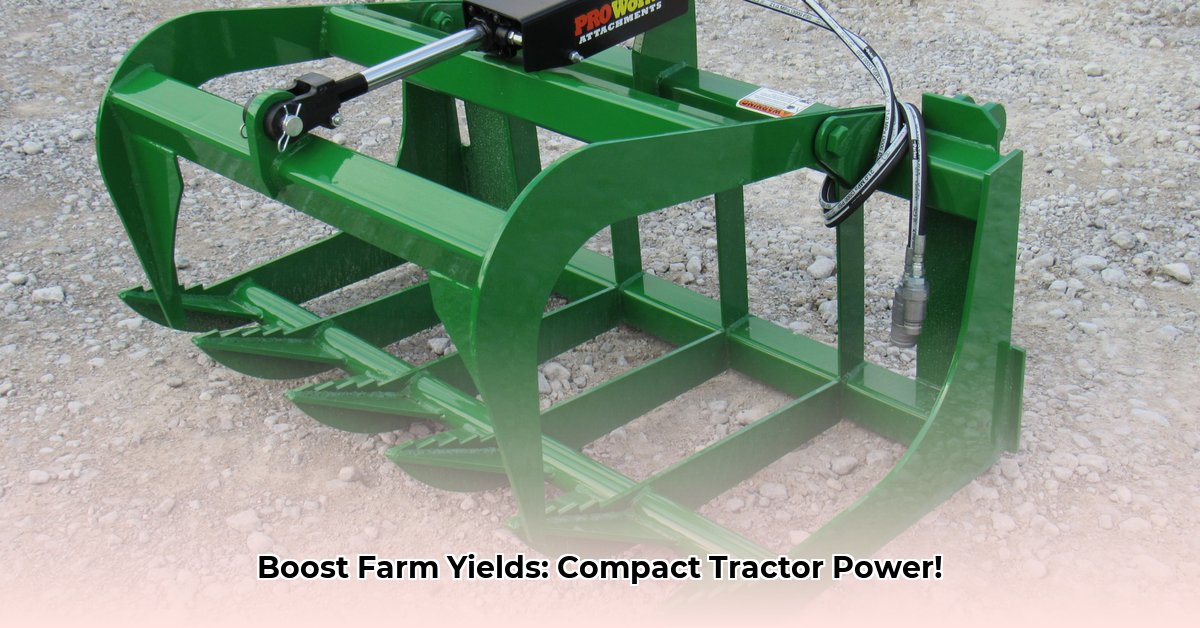
Compact Tractor Loader Attachments: Revamping Your Sustainable Farm
Running a sustainable farm is challenging. Juggling soil health, maximizing yields, and minimizing costs can feel overwhelming. But what if you could streamline operations and boost efficiency? Compact tractor loader attachments offer a powerful solution, transforming how you work and boosting your farm's sustainability. They're not just add-ons; they're versatile tools that adapt to your needs, helping you work smarter, not harder. Aren't increased efficiency and environmental responsibility key goals for any modern farmer? For a comparison of different compact tractors, check out this helpful chart.
Choosing the Right Tools for Your Farm's Personality
The beauty of these attachments lies in their flexibility. They're like a specialized toolbox, each tool designed for a specific job. But with numerous options, how do you choose the right ones?
Let's explore popular attachments and their benefits for sustainable practices:
Buckets (the workhorses): Standard buckets handle general tasks. For specialized needs:
- Lightweight Buckets: Minimize soil compaction for delicate operations.
- Heavy-Duty Buckets: Tackle rocks and heavy loads – ideal for land clearing.
- Buckets with Integrated Augers: Direct seeding from your tractor – a significant time-saver.
Box Scrapers (for precision leveling): Essential for soil preparation, smoothing uneven terrain, and creating ideal seedbeds. They're your precision land shapers.
Root Grapples (for efficient land clearing): Quickly and efficiently clear brush and stubborn roots, reclaiming land and improving farm aesthetics.
Pallet Forks (for streamlined logistics): Move pallets of feed, supplies, or harvested goods quickly and safely, reducing manual labor.
Post Hole Diggers (for easy fencing and tree planting): Quickly and accurately dig holes, saving you time and effort.
Tooth Bars (for soil aeration): Improve soil aeration and nutrient distribution by breaking up compacted soil, fostering healthier crops and reducing the need for chemical fertilizers. This directly supports sustainable farming practices. Don't you want healthier soil leading to healthier crops?
Getting the Most Out of Your Attachments
Selecting the right attachments is crucial, but effective use is equally important. Maximize their impact with these tips:
Right Tool, Right Job: Use the appropriate attachment for each task. Avoid using heavy-duty attachments for light work.
Regular Maintenance: Regular inspection, lubrication, and sharpening prevent breakdowns and ensure peak performance. Preventative maintenance saves time and money.
Optimize Tractor Settings: Experiment with your tractor's hydraulics and settings to find the optimal configuration for each attachment. Consult your manufacturer's manual.
Prioritize Safety: Always read and follow the manufacturer's safety guidelines. Proper training is essential.
The Long-Term Perks: Sustainable Farming, Sustainable Profits
Investing in quality compact tractor loader attachments is an investment in your farm's future. These tools significantly boost efficiency, saving you time, labor, and fuel. They also promote sustainable practices by minimizing soil compaction and reducing reliance on heavy machinery. It’s a win-win for your bottom line and the environment.
Improved soil health contributes to higher yields and lower input costs. This reduction in your carbon footprint benefits your business, community, and the planet. Isn't a healthier, more productive farm a worthwhile goal?
How to Calculate the Long-Term Cost-Effectiveness of Custom Tractor Attachments for Sustainable Soil Management
Understanding the long-term financial implications of compact tractor attachments is crucial. Let’s explore how to assess their cost-effectiveness for sustainable soil management.
Assessing Your Needs and Available Attachments
First, identify your farm's specific soil challenges. Different attachments address different problems. A subsoiler tackles compaction, while a ripper improves drainage. Matching the right tool to the problem is key to maximizing ROI.
Calculating Initial and Operational Costs
Calculate the purchase price, modifications, delivery, and installation costs. Then estimate operational costs: fuel consumption (monitor usage with and without the attachment), maintenance (research typical schedules and costs), and labor costs.
Projecting Long-Term Benefits
Estimate the impact on:
- Increased Yields: Research suggests improved soil health correlates with higher yields. Quantify this potential increase.
- Reduced Input Costs: Less fertilizer? Estimate savings.
- Improved Soil Health: This is less easily quantified but crucial for long-term sustainability.
- Labor Savings: How much time will the attachment save?
Calculating Return on Investment (ROI)
A simple ROI calculation is: (Total Benefits - Total Costs) / Total Costs. Use conservative estimates and consider using a spreadsheet to track costs and benefits over time.
Example: Subsoiler vs. Box Blade (Simplified)
| Attachment | Initial Cost | Annual Maintenance | Annual Fuel Cost | Increased Yield (per acre) | Reduced Fertilizer Cost (per acre) |
|---|---|---|---|---|---|
| Subsoiler | $2,000 | $100 | $50 | 10 bushels | $15 |
| Box Blade | $1,000 | $50 | $25 | 5 bushels | $5 |
(Note: This is a simplified example. Tailor figures to your specific farm.)
Remember: sustainability benefits extend beyond immediate financial gains. They impact the long-term health of your soil and the overall environmental footprint of your farming operation.